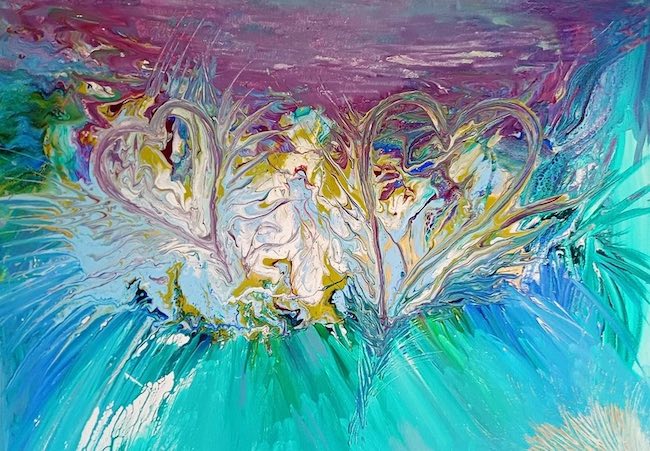Il mondo interiore di ciascun artista è un mistero che si svela attraverso la capacità di esprimere sensazioni diversamente impossibilitate a fuoriuscire oppure troppo complesse per essere comprensibili e riconoscibili, così la capacità di dar vita a opere d’arte va di pari passo con un’evoluzione personale e consapevolezze che senza quel dono innato resterebbero all’interno delle pieghe della quotidianità. Riuscire a liberarsi di tutti quei limiti che intrappolano le profondità dell’anima mette dunque i creativi in una posizione privilegiata, anche per la libertà di poter scegliere il linguaggio più affine alla propria indole, costituendo quasi inconsapevolmente un’esortazione all’osservatore a compiere il medesimo percorso di introspezione, facendosi trascinare dalle immagini narrate dagli artisti. La protagonista di oggi sceglie uno stile indecifrabile dalla ragione per permettere a se stessa di compiere quel distacco dalla contingenza che le è necessario all’approfondimento di sé e alla conoscenza di quelle impercettibili verità che vanno a ricomporsi attraverso la pittura.
Nel momento in cui, intorno agli anni Quaranta del Novecento, si verificò una sorta di presa di coscienza di quanto tutte le correnti informali avessero allontanato l’espressione artistica da quell’emozionalità che invece era stata teorizzata e mantenuta da Vasily Kandinsky, considerato il fondatore dell’Arte Astratta, divenne chiaro che fosse necessario colmare quella distanza, quel distacco tra purezza del gesto plastico e il mondo soggettivo dell’esecutore dell’opera, così come tornare a far vibrare le corde interiori dell’osservatore. L’eccessivo rigore e intellettualismo dell’Astrattismo Geometrico, del De Stijl, del Suprematismo e del Concettualismo, avevano allontanato il pubblico che aveva perso il coinvolgimento verso le opere, elemento essenziale per conquistare lo sguardo attraverso le emozioni; dunque negli Stati Uniti, dove molti esponenti del mondo dell’arte europea erano stati costretti a rifugiarsi per salvarsi dalla guerra, nacque un gruppo eterogeneo nello stile quanto in perfetto accordo sull’intento e lo scopo reale dell’arte, quello di far vibrare le corde interiori dell’esecutore dell’opera quanto dell’osservatore. L’Espressionismo Astratto, questo il nome del movimento che ben presto si diffuse in tutto il mondo, ebbe come capogruppo Jackson Pollock, affiancato dalla determinazione e dalla cooperazione di Mark Rothko, Franz Kline, Willem de Kooning, e si pose l’ambizioso obiettivo di scuotere il mondo dell’arte contemporanea del tempo, troppo legata alle regole precedenti e orientata a riconoscere solo correnti già note e accademicamente accettate; loro invece volevano introdurre gli elementi mancanti, quello del gesto che entrava di diritto a far parte dell’opera, ecco perché fu proprio con loro che nacque l’Action Painting, e quello di quel mondo interiore, più o meno istintivo e irruento sulla base dell’inclinazione pittorica di ciascun interprete del nuovo stile, che non poteva e non doveva più essere messo in disparte. Color Field, laddove l’approccio pittorico era più contemplativo, il Tachisme quando invece la vivacità cromatica aveva bisogno di predominare per interpretare il sentire dell’autore dell’opera, la Pittura Segnica se l’essenzialità del messaggio doveva emergere con una sola voce, tutte manifestazioni di un comune denominatore, quello della liberazione del mondo interiore. Il rigore dei movimenti informali precedenti lasciò dunque il posto al caos dell’impulso, all’improvvisazione legata solo e unicamente a un sentire a cui i colori dovevano assecondarsi e assoggettarsi per far nascere opere in grado di parlare all’interiorità del fruitore.
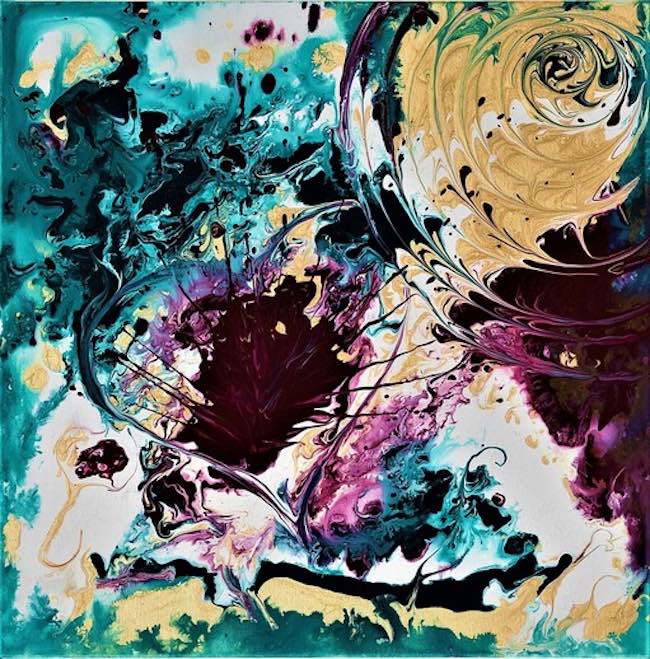
L’artista abruzzese Vanessa Di Lodovico sceglie esattamente questo tipo di linguaggio pittorico per effettuare un cammino di autocoscienza, di apprendimento delle proprie stesse debolezze e fragilità che solo attraverso la consapevolezza possono trasformarsi in punti di forza; il percorso di scoperta va di pari passo alla liberazione del suo lato più emotivo, quello che nella realtà quotidiana, fatta di organizzazione della contingenza con due figlie a cui badare e del suo lavoro in banca che la lega fortemente alla parte più razionale, non riesce a fuoriuscire. L’inizio del percorso nell’arte coincide con il distacco dalla famiglia di nascita, necessario per vivere in maniera più indipendente la propria vita, e forse l’esigenza di interrogarsi, di comprendere maggiormente tutti i dubbi, le perplessità, le domande che non possono fare a meno di caratterizzare la sua giovane età dell’epoca, sono tutti elementi che hanno contribuito a spingerla verso l’arte, verso quella purezza espressiva che si lega fortemente a un’interiorità che non voleva più restare intrappolata all’interno delle regole e dei doveri sociali o della realtà contingente.
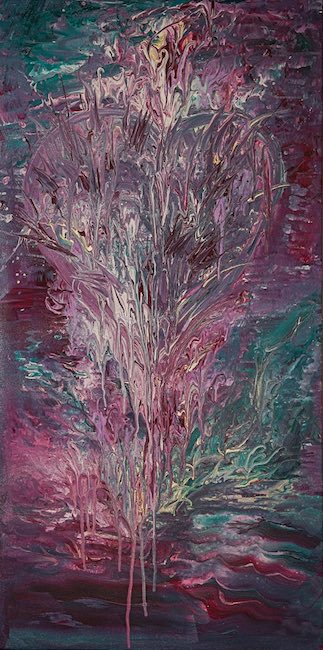
Man mano che la sua mano pittorica diveniva più sicura, Vanessa Di Lodovico si trasformava, apprendendo a togliere solo davanti alla tela quelle maschere che nel mondo ordinario, lei, come d’altronde la maggior parte delle persone, è costretta a indossare per formalismo, per abitudine o semplicemente per proteggere le fragilità interiori che altrimenti resterebbero scoperte.
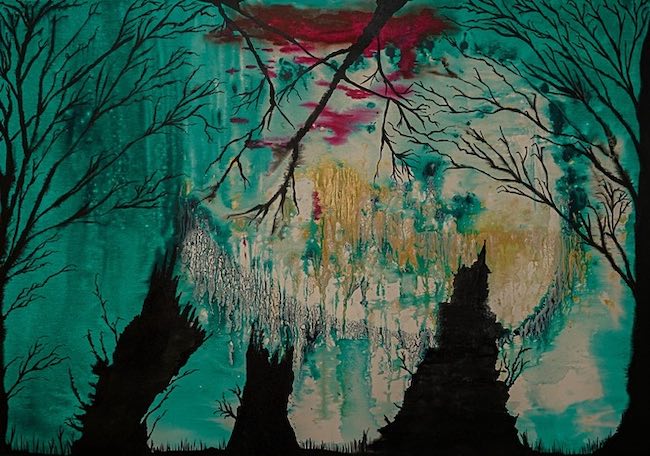
Ogni sua opera corrisponde a un pensiero, una considerazione, un frammento di idea che ha attraversato la sua anima fino a giungere alla coscienza che l’ha poi trasformata in manifestazione artistica; la gamma cromatica si associa a quelle sensazioni in maniera libera e persino al di fuori dell’immaginario comune o di ogni regola prestabilita, legandosi solo e unicamente a quanto ogni colore sia giusto per quella determinata emozione secondo il suo punto di vista.
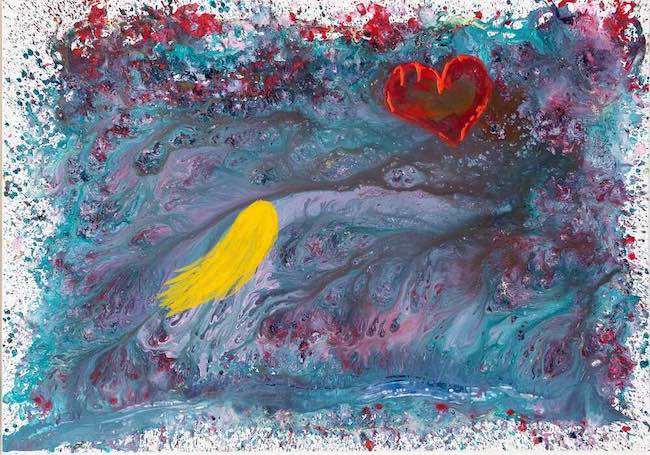
In Con me per sempre Vanessa Di Lodovico si sofferma sul sentimento più nobile, quello dell’amore inteso nel senso più ampio del termine perché declinabile a tutti i tipi di legami che entrano a far parte della vita di un individuo; nel lasciar fluire le sue sensazioni l’artista sceglie di introdurre elementi personali, codici segreti che in qualche modo legano indissolubilmente l’opera al proprio vissuto. La gamma cromatica appare delicata, lieve, giocata sulle tonalità impalpabili dell’emozione, dell’anima, come se quegli elementi personali fossero cullati dalla morbidezza di ciò che li circonda; ed è proprio in quella totalità che si va a perdere lo sguardo dell’osservatore, in quel coinvolgersi in virtù di emblemi universali come il cuore, ampiamente ripreso e stilizzato persino dalla Pop Art, che diviene icona dell’essenza del dipinto.
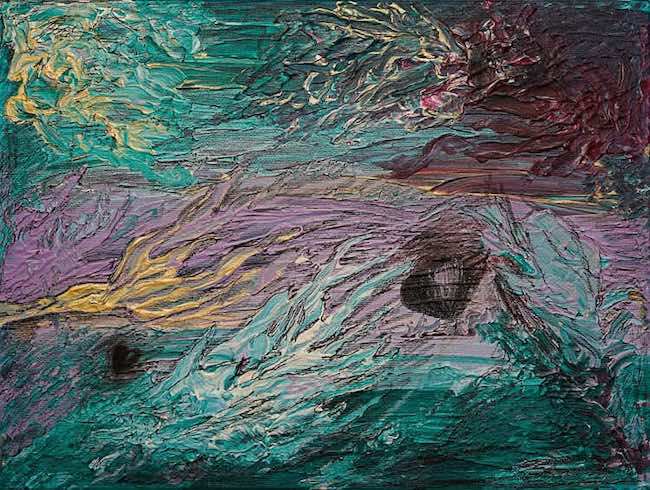
In Breathless invece la Di Lodovico utilizza il colore con maggiore densità, come se in qualche modo volesse sottolineare la consistenza di quella circostanza, di quell’episodio che le ha tolto il respiro, con accezione assolutamente positiva perché in fondo è questo l’approccio dell’artista nei confronti delle proprie emozioni, riconoscendolo come un moto liberatorio attraverso cui raccontare ciò che con le parole non riuscirebbe a dire. Dunque le tonalità sono tenui, persino evanescenti come il verde acqua, o più concrete come l’intenso e vigoroso giallo e l’emozionale porpora sfumato poi verso il rosa, e infondono nel fruitore quella sensazione di perdersi a sua volta all’interno della sensazione emanata dall’artista, lasciando che la comunicazione con l’opera avvenga a livello istintivo. Il messaggio parte dalla soggettività raggiungendo un’altra soggettività con diverso vissuto, con differente sensibilità, eppure riesce comunque a muovere quelle corde interiori che spesso hanno solo bisogno di essere sollecitate in maniera sottile per riuscire a trovare una voce.

Ma una personalità tanto divisa tra razionalità e dimensione emotiva come quella di Vanessa Di Lodovico, non poteva non dedicare una tela anche all’altra parte di sé, quella di cui deve necessariamente vestirsi nella vita di tutti i giorni, ben distante da quel mondo più coinvolgente della pittura; e così l’opera Logos parla esattamente del pragmatismo, del senso pratico, del ragionamento che troppo spesso diviene prigione dell’anima, questo è il motivo per cui viene rappresentata con colori terrosi, scuri, ramificati proprio per sottolineare i ragionamenti che si avvolgono l’uno sull’altro costituendo una rete da cui poi, finché non ci si allena a farlo o finché non si scopre un modo per oltrepassarla come è successo a lei, diventa sempre più difficile liberarsi. Tuttavia in qualche modo anche all’interno di quel mondo più rigoroso è possibile trovare una luce, possibilità che si delineano quando al rigore si associa il possibilismo, rappresentato dal colore giallo chiaro.

Vanessa Di Lodovico ha al suo attivo diverse mostre personali e la partecipazione a collettive nella sua regione, ma è ben determinata a farsi conoscere da un pubblico più ampio e internazionale.
VANESSA DI LODOVICO-CONTATTI
Email: vdilod@gmail.com
Sito web: https://www.vanessadilodovico.it/
Facebook: https://www.facebook.com/profile.php?id=100090424932400
Instagram: https://www.instagram.com/vanessa.dilodovico/
Vanessa Di Lodovico’s Abstract Expressionism, to bring order to the chaos of emotions by discovering the deepest identity
The inner world of each artist is a mystery that reveals itself through the ability to express sensations that are otherwise impossible to escape or too complex to be comprehensible and recognisable, so the ability to give life to works of art goes hand in hand with a personal evolution and awareness that without that innate gift would remain within the folds of everyday life. Being able to free themselves of all those limits that trap the depths of the soul therefore puts creative artists in a privileged position, not least because of the freedom of being able to choose the language most akin to their own nature, almost unconsciously constituting an exhortation to the observer to follow the same path of introspection, letting himself be carried away by the images narrated by the artists. Today’s protagonist chooses a style that is indecipherable by reason to allow herself to make that detachment from contingency that is necessary for the deepening of self and the knowledge of those imperceptible truths that are recomposed through painting.
When, around the 1940s, there was a sort of realisation of how far all informal currents had distanced artistic expression from the emotionality that had been theorised and maintained by Vasily Kandinsky, considered the founder of Abstract Art, it became clear that it was necessary to bridge that distance, that detachment between the purity of the plastic gesture and the subjective world of the artwork’s executor, as well as to return to making the observer’s inner chords vibrate. The excessive rigour and intellectualism of Geometric Abstractionism, De Stijl, Suprematism and Conceptualism, had alienated the public who had lost the involvement with the artworks, an essential element to win the gaze through emotions; therefore, in the United States, where many exponents of the European art world had been forced to take refuge to save themselves from the war, a group was born that was as heterogeneous in style as it was in perfect agreement on the real intent and purpose of art, that of vibrating the inner chords of the author of the artwork as of the observer. Abstract Expressionism, this is the name of the movement that soon spread throughout the world, was led by Jackson Pollock, flanked by the determination and cooperation of Mark Rothko, Franz Kline and Willem de Kooning, and set himself the ambitious goal of shaking up the contemporary art world of the time, which was too tied to previous rules and oriented towards recognising only well-known and academically accepted currents; they, on the other hand, wanted to introduce the missing elements, that of the gesture that became by right part of the artwork, which is why it was with them that Action Painting was born, and that of that inner world, more or less instinctive and impetuous on the basis of the pictorial inclination of each interpreter of the new style, which could not and should no longer be sidelined. Colour Field, where the pictorial approach was more contemplative, Tachisme when chromatic vivacity needed to predominate in order to interpret the feeling of the author of the work, Signic Painting if the essentiality of the message had to emerge with a single voice, all manifestations of a common denominator, that of the liberation of the intimate world. The rigour of the previous informal movements thus gave way to the chaos of the impulse, to improvisation linked solely and exclusively to a feeling to which the colours had to comply and submit in order to give birth to artworks capable of speaking to the interiority of the viewer. The artist from Abruzzo, Vanessa Di Lodovico, chooses precisely this type of pictorial language to embark on a path of self-awareness, of learning about her own weaknesses and fragility, which can only be transformed into strengths through awareness. The path of discovery goes hand in hand with the liberation of her more emotional side, the side that in daily life, made up of the organisation of contingency with two daughters to look after and her work in a bank that strongly binds her to her more rational side, cannot escape. The beginning of her journey into art coincided with the detachment from her family of birth, necessary to live her life more independently, and perhaps the need to question herself, to better understand all the doubts, perplexities and questions that could not help but characterise her young age at the time, were all elements that contributed to pushing her towards art, towards that expressive purity that was strongly linked to an interiority that no longer wanted to be trapped within social rules and duties or contingent reality. As her painterly hand became more confident, Vanessa Di Lodovico transformed herself, learning to remove those masks that in the ordinary world, she, like most people, is forced to wear out of formalism, habit or simply to protect inner fragilities that would otherwise remain uncovered. Each of her artworks corresponds to a thought, a consideration, a fragment of an idea that has passed through her soul until it reached the consciousness that then transformed it into an artistic manifestation; the chromatic range associates itself with those sensations in a free manner and even outside the common imagination or any pre-established rule, binding itself solely and exclusively to what each colour is right for that particular emotion according to her point of view. In With me forever Vanessa Di Lodovico dwells on the noblest sentiment, that of love understood in the broadest sense of the term because it can be applied to all the types of bonds that become part of an individual’s life; in letting her feelings flow, the artist chooses to introduce personal elements, secret codes that somehow indissolubly link the artwork to her own experience. The chromatic range appears delicate, light, played on the impalpable tones of emotion, of the soul, as if those personal elements were cradled by the softness of what surrounds them; and it is precisely in that totality that the observer’s gaze gets lost, in that involvement in virtue of universal emblems such as the heart, widely taken up and stylised even by Pop Art, which becomes an icon of the essence of the painting. In Breathless, on the other hand, Di Lodovico uses colour with greater density, as if in some way she wanted to emphasise the consistency of that circumstance, of that episode that took her breath away, with an absolutely positive meaning because this is, after all, the artist’s approach to her emotions, recognising it as a liberating motion through which to recount what she could not say with words. Hence the tones are soft, even evanescent such as teal, or more concrete such as the intense and vigorous yellow and the emotional purple shading towards pink, and instil in the viewer that feeling of losing oneself in turn within the sensation emanating from the artist, allowing communication with the work to take place on an instinctive level. The message starts from subjectivity, reaching out to another subjectivity with a different experience, with a different sensitivity, and yet it still manages to move those inner chords that often only need to be urged in a subtle way to find a voice. But a personality as divided between rationality and emotional dimension as that of Vanessa Di Lodovico, could not fail to dedicate a canvas also to the other part of herself, the part that she must necessarily wear in everyday life, far removed from that more involving world of painting; and so the work Logos speaks precisely of pragmatism, of the practical sense, of the reasoning that all too often becomes a prison of the soul, which is why it is represented with earthy, dark, branching colours precisely to emphasise the reasoning that wraps around one another, forming a net from which, until one trains oneself to do so or until one discovers a way to go beyond it as has happened to her, it becomes increasingly difficult to free oneself. Yet somehow even within that more rigorous world it is possible to find light, chances that emerge when rigour is associated with possibilism, represented by the colour light yellow. Vanessa Di Lodovico has several solo exhibitions and participation in group shows in her region to her credit, but she is determined to make herself known to a wider, international audience.


